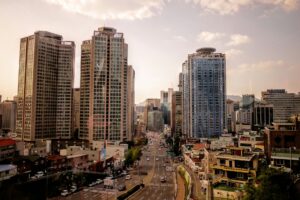Seoul Housing Policy
Introduction:
Until the local government system came into effect in 1995, Seoul focused its housing policy mainly on supplying houses to meet the demands caused by population growth. The city’s population rose dramatically from 2.45 million in 1960 to 5.43 million in 1970, 8.36 million in 1980, and 10.61 million in 1990, but the amount of housing fell far short of the growth. Seoul was in perpetual need of housing.
The housing shortage caused by Korea’s continued economic growth and urbanization often precipitated housing price increases and speculation. Finding solutions for this problem has always been a crucial national challenge while the country was enjoying rapid economic growth, and was the reason that housing supply and price control policies were alternately implemented in response to the cycle of housing shortage, followed by rising house prices, followed by speculation and then control policies.
Massive Supply of Housing:
Revision of Institutional Measures for a Massive Supply of Affordable Sites & Housing Policy:
Until the mid-1950s, the government’s housing policies amounted to no more than emergency aid. With the 5-Year Economic Development Plan in 1961 however, policies began to look like construction policies. In 1962, the Korea National Housing Corporation was created to aggressively respond to the housing shortage; in 1967, the Korean Housing Fund was established. The Land Readjustment Program Act was passed in 1966 to take on systematic construction of the urban area. In the mid-1970s, the institutional framework was founded to supply more affordable housing.
Mass Supply via Public Development:
Judging from detached houses alone could not resolve the shortage in Seoul, the government initiated a policy designed to supply housing on a massive scale via public development in the 1970s. For this development, the Housing Construction Promotion Act and the Housing Site Development Promotion Act were passed in 1972 and 1980, respectively. In 1976, the Urban Planning Act adopted an apartment district system to facilitate apartment supply, designating Banpo, Apgujeong, Seocho, Dogok, Cheongdam and Gaepo as such areas – the areas that had been developed in accordance with the Land Readjustment Program.
Housing was built in earnest under the 10-Year Housing Construction Plan in 1972. In line with the plan to supply 2.5 million units between 1972 and 1981, some 1.87 million were built nationally with 497,000 units in Seoul. However, the programs pursuant to the Housing Construction Promotion Act only targeted residential areas within the boundaries of the urban plan zone, and supplying land on a large scale became an issue.
Redevelopment of Deteriorating Housing in the 1980s:
In the early phase of industrialization, a large amount of unauthorized housing was built throughout Seoul. These “slum” areas were mostly located on hillsides adjacent to urban areas and were often called by their nickname, Dal-Dongne. The Dal-Dongne redevelopment projects began in earnest after passage of the Urban Redevelopment Act in 1976.
Purchased Housing for Lease and Housing Policy for Permanent Lease:
The policy for permanent lease housing, pursued in line with the plan to supply 2 million houses, was the first housing welfare policy for the poorest class, including those covered by the livelihood protection scheme. Permanent lease housing was deemed innovative because 85% of the construction cost was financed from the national coffer. It inevitably put a strain on the national budget, forcing a stop to the program after 190,000 units were built nationwide.
From 2003, multi-unit houses were purchased in the downtown area as part of the purchased housing policy to be used for lease to those in the lowest income class. Purchased housing for lease was available in built-up areas and tenants were very satisfied with the policy. In 2005, the government introduced a system where it leases private houses from the owners and then sub-leases them out to low-income tenants.

Conclusion:
Housing policy in South Korea has maintained home ownership as its goal, through economic and income growth. The full-scale housing site development program that began in the early 1980s developed green zones on the city outskirts to keep the supply of housing affordable. This in turn allowed housing prices to stay low, thereby encouraging more people to own homes and increasing the size of the middle class. After the Asian financial crisis however, the financial market for the real estate industry opened, accelerating housing price increases and the resulting size of mortgages. Because housing prices rose faster than income levels, home ownership in Seoul has remained near the 40% level despite the massive supply of housing.
Also Read: Alternative Low Cost Construction Materials & Techniques
